
See also: ..... DUMMY TRAINING RIFLES ......... and ........ FENCING MUSKETS
Whilst neither carrying the highest Rifle Number (of the original nomenclature), which privilege is held by the Lee-Enfield Rifle No.9 converted for the Royal Navy, nor being a "live" longarm, this rifle is generally regarded as the last true Lee-Enfield rifle model to be produced. We are grateful to have been afforded permission to here copy an article written, by the foremost authority on the subject, for "Dispatches", the Journal of the Lee-Enfield Rifle Association (see Links).
The author was the senior armourer responsible for preparing the specification of the military deactivation to which selected Lee-Enfield No.4 rifles were subjected.
It will become evident why the notes commence with the L59A2. Further images and details of the L59A1 will soon be available.
THE ALMOST FORGOTTEN ENFIELD - The ‘DRILL RIFLE L59A2’

Images of the L59A2 D.P. - S.M.L.E. conversion are the work of the authour by courtesy of the U.K. MoD, Warminster.
"It has long been accepted that the last numerical rifle from the Enfield stable was the ‘DRILL RIFLE, L59A1’.
This is the old trusty No.4 of various marks, converted to Drill Purpose specification by various machining and welding processes applied to the body, barrel and bolt. Additionally, it has 2” wide painted bands around the butt and fore-end/ handguard marked with the letters ‘DP’. As a DP rifle or simple inert training aid, its VAOS (Army Ordnance stores category) was deemed to be of no value. Incidentally, if you don’t already possess one of these L59’s in your collection, now is the time to acquire one, while they are still available!
I won’t go into the security reasons that are quite obvious, but these ‘rifles’ were formulated during the 1970’s and early 1980’s for use by Cadet Forces. Many thousands of No.4 rifles, Bren guns and L1A1 rifles (for the Navy Combined Cadet Forces and parachute training) were also being rebuilt to DP specification, and the provisional ‘L’ series numbers were being allocated; that for the No.4 rifle being L59; and for the L1A1, the L60A1.
The trials were undertaken
by the Armourers Shop, 43 Command Workshops REME at Aldershot under the
control of Brian Sylvester as directed by 14 Maintenance Advisory Group.
The first problem was that it soon became clear that there were still No.1
(S.M.L.E.) rifles
within the Cadet system that had been overlooked. While they were all nominally
.303” rifles, albeit No.1’s and No.4’s, the No.1 rifles
were not in any way similar to the No.4 and the machining jigs could not
be made to fit or adapt to it! UK MoD obtained about 6, but the exact quantity
is unclear, worn out No.1 rifles from the trade to formulate a conversion
programme for those No.1 rifles still within the cadet system, especially
the school CCF’s.
Thousands of No.4 rifles were completed, but progress on the No.1 programme
was slow. Not least, because spares for repair and breakages were in short
supply. While this was being undertaken, events had overtaken the project
because, while the No.4 was designated ‘DRILL RIFLE L59A1, the slightly
- but everso different - No.1 was to have become the DRILL RIFLE, L60A1.
But events had moved on and in Navy Cadet use L1A1 (and parachute training at Brecon) had become the DRILL RIFLE L60A1 .............. it’s getting worse! So the same-meat-different-gravy No.1 was to become the DRILL RIFLE L59A2. Phew! Additionally, while it was one thing to machine and structurally weaken the left and right body side of a No.4, the No.1 body was a different and more difficult kettle of fish, due to it being more rounded and extremely difficult to hold while being machined.
Les Alexander told
the author that even engraving the side with the pantograph engraver was
difficult. Not the actual machining, but the holding. Two styles of engraving
were used. First, with the DRILL RIFLE
L59A2, in a straight line on the left side, to the rear of the breeching
up ring and similarly, but with the L59A2, below the words DRILL RIFLE.
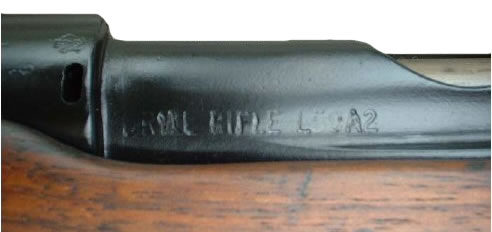 Left:
the markings "DRILL RIFLE L59A2". Not very clear but the actual
engraving was exactly as Les Alexander described it! Difficult to hold and
difficult to cut because the body sides were all shapes and sizes!
Left:
the markings "DRILL RIFLE L59A2". Not very clear but the actual
engraving was exactly as Les Alexander described it! Difficult to hold and
difficult to cut because the body sides were all shapes and sizes!
After much discussion between the workshops, 14 MAG, the Cadet advisory
teams and the Inspecting circuit Armourers, it became clear that in reality,
only a few schools had any No.1 rifles to convert. In fact there were less
than 50 No.1 rifles within the CCF’s across the whole of Southern
England and, magnified across the UK, the number will probably have been
of the order of 300 or so.
While some of these were serviceable, most were not. The question then arose as to why weren’t they serviceable if they were still in service with the school CCF. Using a couple of schools as good examples, it transpired that Sherborne School CCF had about eighteen No.1 rifles, but these were bought by the school after the war for the princely sum of £1 each, to restart the CCF again after its original weapons were removed in 1940! And they didn’t belong to the MoD in any case! Similarly, Radley College in Oxfordshire had about eight No.1’s, purchased in similar circumstances and, while they were nominally on the school WOCS (War Office Controlled Stores) register, they didn’t belong to the MoD either! And so it probably went on throughout the CCF system.
Quite clearly, it was uneconomic and a nonsense to continue the project for a mere 300 or so ‘rifles’ that would have a value of NIL once the programme was finished, so the straight talking, no nonsense WO2’s Roger Traves an Ian Knight pulled the plug. The decision was then taken that if these schools returned their No.1 rifles through the usual Ordnance channels, quoting the EMER reference, then they’d be replaced with service or DP No.4’s, the now L59A1, regardless of whether they were ‘private purchase’ or UK MoD issue.
The project to convert
the No.1 rifle to DP was abandoned. Of the 6 rifles, one was used as a slave
and kept by Brian after the project. It was finished and, afterwards, withits
white bands removed, was on display in the foyer of the Aldershot Armourers
shop. It was destroyed when the workshop closed in the mid 1980’s.
Certainly one was destroyed while being machined and used for spare parts.
Another, R-345 (but K-345 according to the paper trail!) went to Radley
College in Oxfordshire for evaluation, where it eventually adorned the RSM’s
Office, and another went to (it is believed ..) Marlborough College in Wiltshire
for evaluation too. The other ‘two or three …’ were stripped
for
spares and returned to Ordnance.
There were two interesting sequels to this tale. The first, related to me by Roger Smith, one of the senior examining Armourers, was that during this project, surprised that these No.1 rifles were still in the ‘system’, feelers were put out to find exactly what No.1 rifle spare parts were actually within the UK Ordnance. There were certainly some fore-ends and front handguards, backsights, bolt heads and many assorted screws, plus the general parts that are interchangeable with the No.4. While, amazingly, there were boxes and boxes of bayonet grips and catches too that someone, somewhere, had assumed and catalogued wrongly as No5 bayonet spares! He commented ‘… …and to think that while they had these, we were hunting around for current Lee-Enfield No.8 Rifle butt plates, foresight protectors and magazine well inserts!’
The second sequel revolved
around a Drill Rifle L60A1, the Navy (and parachute training) L1A1 DP conversion.
Recently one of these was found in private hands by a Police Force who questioned
its legality as a firearm, as defined. The matter was referred back to the
UK MoD and came winging across Captain Mainwaring's desk one bright sunny
morning! The decision was made that while the ‘rifle’ did not
have a deactivation certificate, it remained inert and, even though it was
capable of feeding and loading a drill-round (as it was intended don’t
forget … …),
it was deemed to be deactivated to beyond the Home Office required standard
and was returned to the owner. Just how it escaped was not questioned. In
any case, it’s ‘loss’ value was NIL … … and
time is a great healer … …
Captain Mainwaring
......................................................................................................................................................................................................... DISPATCHES 4 July 2007
MORE IMAGES OF THE L59A2
The slot in the barrel, just ahead of the tip of the chambered bullet, the
point of maximum pressure. 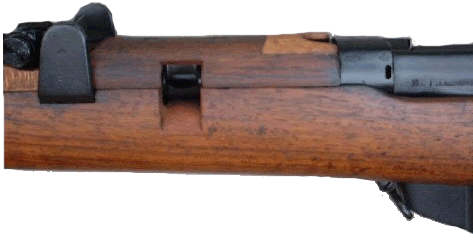 This
was formulated in size so that if a live round was chambered and fired,
then the venting gas would leave insufficient to project the bullet out
of the bore. Additionally, by being vented on the left, the venting gas
would cause least damage to the holding hand. This vent was not exactly
where we wanted it, but the location of the handguard springs dictated its
exact place.
This
was formulated in size so that if a live round was chambered and fired,
then the venting gas would leave insufficient to project the bullet out
of the bore. Additionally, by being vented on the left, the venting gas
would cause least damage to the holding hand. This vent was not exactly
where we wanted it, but the location of the handguard springs dictated its
exact place.
This picture also shows the undercut wood patch in the rear handguard, presumably
to eliminate a split. Another time consuming job for little David Lines.
 The
DP marking. A 2” white band, 2” from the rear of the nose cap.
The bayonet was not an official sanction for this rifle. From the 1920’s
onwards,until the mid 1970’s to early 1980’s, it was worn by
the duty Cadet; but health and safety decreed that the practice must stop.
This was then blunted and DP’d solely for this purpose, and a slight
‘ding’ put into the ring to prevent it being fitted to a rifle.
It was rectified for this photo. But they look ‘right’ together.
The
DP marking. A 2” white band, 2” from the rear of the nose cap.
The bayonet was not an official sanction for this rifle. From the 1920’s
onwards,until the mid 1970’s to early 1980’s, it was worn by
the duty Cadet; but health and safety decreed that the practice must stop.
This was then blunted and DP’d solely for this purpose, and a slight
‘ding’ put into the ring to prevent it being fitted to a rifle.
It was rectified for this photo. But they look ‘right’ together.
What is not shown is that the barrel is welded into the body, and the bolt
face is welded up flat and a small slot is machined down the underside surface
of the bolt-head. There is a small hardened steel stud in the boltway that
prevents a standard bolt-head from moving in the bolt-way.
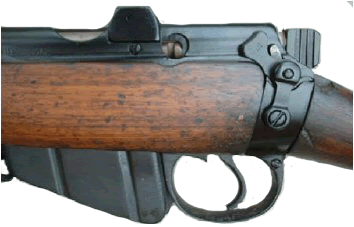
Right: the left side of the body showing the milling cut directly into the
left side locking cam on the body, thereby removing completely the integral
structural strength of the body locking lugs. Also clearly shown is the
ground slot from the bottom locking lug of the bolt. This has ensured that
the body and bolt are totally and structurally weakened. Note also, the
copper plated bolt.
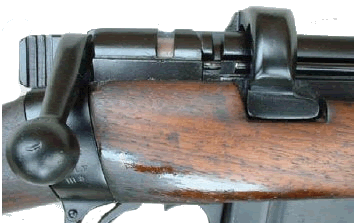
Left: the right body side showing the structural weakening of the right
side locking cam surface. Also shown is the long locking column of the bolt,
machined just ahead of the induction hardened locking surface. This has
partially broken the inherent structural locking strength of the bolt."
The author of this article has also answered related forum queries elsewhere.
With his permission we copy some of these points, which provide useful and detailed information.
To queries about Royal Air Force DP rifles he replies .... be advised that the RAF DP's will be clearly identified as such by having the 1/2" hole drilled RIGHT THROUGH the top wood (Guard, hand, lower), barrel and lower wood (fore-end) approx 1.625" forwards of the centre line of the screw, guard, trigger, front ....the front trigger guard screw!
The RAF painted a white band around the fore-end but not the butt. The Army L59's had the white band around the butt AND fore-end/handguard and marked DP in white. This was because until the whole RAF, Royal Navy and Army stores systems were centralised in the late 80's (under the nemonic ABSDA and lated DSDA), each had their own way of doing things.

Image above is of the Royal Air Force L59A1 DP Rifle and markings - by courtesy of Joe Salter - 'Down East Antiques' - Joe Salter.com
To a second query made about RAF style DP rifles ..... These were formulated in the mid 70's for RAF Cadet use alongside the Army L59 type DP's to counter the terrorist threat. These were a general Cadet issue with the usual RAF 9B/---- stores reference number
The RAF decided to shorten the striker and weld up the bolt face and weld into the rear of the bolt head. But that's where the similarities between it and the L59 ceased. The RAF authorities then decided to drill a 1/2" hole down through the top rear handguard, through the barrel and continue through the fore-end. So that you could in effect, see right through the rifle, top to bottom. So far, so good
The butt was marked DP ONLY across the top of the wrist, to the rear of the cocking piece and the top handguard was also marked simiarly, 1" in front of the hole in the upper handguard.
 This
was all that they did! Cheap, or what! What they didn't consider was that
if some enterprising Cadet put a LIVE bolt into the rifle and fired a blank
..... or worse a live round, because it was important for DRILL PURPOSE
rifles to be able to load a drill round, should he load and fire a round,
the RAF stated that he'd immediately notice the effect by the venting gas
obscuring his line of sight. What they didn't take into account was that
the venting gas from below was positioned so as to take the poor mites fingers
or even his hand off! You might just call it natural selection ......, but
there you go.
This
was all that they did! Cheap, or what! What they didn't consider was that
if some enterprising Cadet put a LIVE bolt into the rifle and fired a blank
..... or worse a live round, because it was important for DRILL PURPOSE
rifles to be able to load a drill round, should he load and fire a round,
the RAF stated that he'd immediately notice the effect by the venting gas
obscuring his line of sight. What they didn't take into account was that
the venting gas from below was positioned so as to take the poor mites fingers
or even his hand off! You might just call it natural selection ......, but
there you go.
So, just to re-emphasise the DP nature of the rifles, instructions were later issued that a 1.5" wide white band was to be painted around the fore-end and top handguard 2" above the lower band. They did consider making the bolt non-removable (except by Armourers) too, but while this is simple for the Mk1, 1/2 and 2 rifles, it's not so simple for the Mk1* and 1/3. These were still in RAF Cadet service until a couple of years ago and so far as I am aware, there never was an accident with one. Maybe RAF Cadets were a bit brighter than your average Army Cadet because you can be sure, if these were in Army Cadet service, as sure as eggs is eggs, there WOULD have been an accident
So there you are, the story of yet another unsung variant of the No.4 rifle. Does anyone have one of these ex RAF DP rifles? Now you know why and where some spare used fore-ends and handguards come from if there's a 1/2" hole from top to bottom. BUT, the story doesn't end there. If you happen to see the RAF Queen's Colours Squadron strutting their stuff, complete in 50's battledress and wielding No.4 rifles, at a memorial service near you, then these too are carefully concealed RAF DP No.4 rifles.
Another useless bit of Lee Enfield history for the archives. [Hardly that; Ed]
_______________________
And to a further query ...... Glad you asked about the L59 DP's. There was going to be an L60 DP (later reverting to L59A1) based on approx 300 or so No.1 rifles still in the school Cadet system. But that's another story........
The L59 was to regularise all of the various features that had been worked into the drill purpose rifles. There is a current UK MoD EMER specification for them, and you have pretty well got it completely in yours. Additionally, the barrel is welded in place and they conform to the current UK deactivation criteria too due to their being '...so structurally weakened' etc., etc. In fact I and a colleague drew up the spec! You haven't said what the new serial number is, but MANY were renumbered SA, two figure year number, Axxxxx (SA77Axxxxx)
Thousands of these were converted during the 70's. Some were quite crudely done I'm afraid, as this was a rush job and, in any case, they were relegated to DP use so would never be fired again. Some workshops had special jigs to cut the wood accurately, while others were done quite roughly. As was the grinding or milling of the barrel by the machine shop.
There could also be a sawn or milled cut
down from the top of the body, just behind the locking shoulders, to structurally
weaken it, and the bolt locking lugs were machined across, just to the rear
of the locking surfaces. There was/should be a hard steel pin inserted into
the bolt-way so that it would foul a fireable bolt-head. The DP bolt-head
had a slot to accommodate the steel pin and allow it to pass.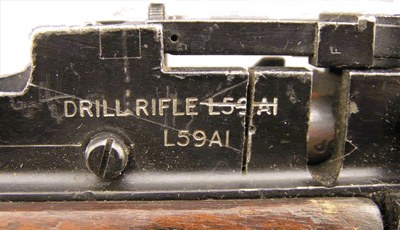
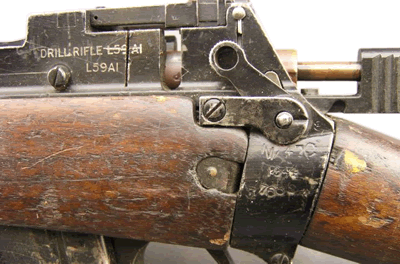
The milled slot mentioned in the text can be clearly seen - Left and Right.
The saw-cut runs through the rifle's original nomenclature mark which appears to have beeen subsequently modified by duplication, possibly after a further deactivation from the original specification.
These two images are shown by kind permission of Joe Salter of 'Down East Antiques' - Joe Salter.com
The "M47C" marking, on the left hand side of the butt socket, indicates that this DP rifle was converted from a Birmingham Small Arms Company manufactured No.4 rifle.
The others that you see, with a hole going DOWN, through the rear handguard, barrel and fore-end were RAF cadet DP rifles. Most of them were also converted to L59 spec too.
The L59 are very interesting rifles that I was involved in, and I hope that every Lee Enfield collector finds one to keep in their collection.
The L59A1 mark conversion was done in various styles and sizes, some small and some large, depending on which workshop did the work. The lettering could read either DRILL RIFLE L59A1 or RIFLE, DRILL or RIFLE, DP but it meant the same. If I were you, I'd tidy the woodwork up, align the wood slots and give it a prized place as, numerically, the LAST true Lee-Enfield. There were only 6 L59A2 No.1 rifles converted just to test the formulation but they were a real pig to do, so the L59A2 project was abandoned.
I'm glad someone asked. Yet another useless bit of Lee Enfield history. [Again, hardly useless information; Ed]
We illustrate what may reasonably be deemed to be a standard model of the L59A1 is illustrated below.

The "DP" marks are stencilled on the white-painted bands only on the LH side of the butt and the underside of the fore-end, where the mark would be most obvious when the rifle was standing in an armoury rack. "DP" is also stamped only on the RH side of the magazine.

The usual markings of such a rifle are shown below.
"DRILL RIFLE L59A1"
with the serial number "171924" of the rifle, as stamped on the LH side of the receiver's butt-socket,
now duplicated below the new nomenclature forward on the side-wall.
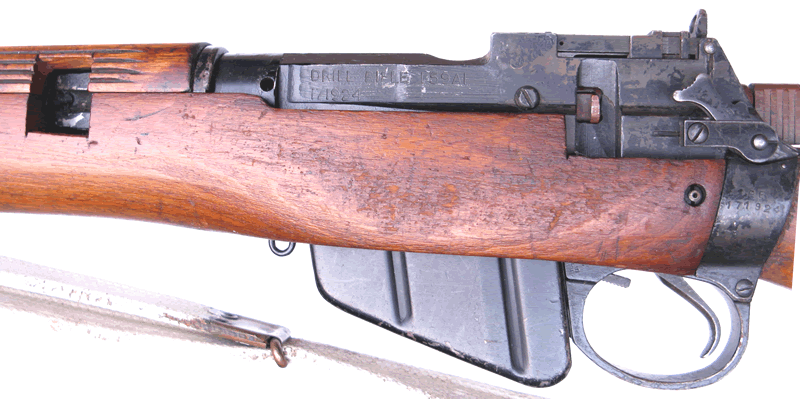
We show several images illustrating the way in which the bolt locking-lugs have been milled with slots to weaken them to the point where any live round fired would develop little forward breech pressure. The bolt should, on firing, only return rearwards as far as the remaining solid section of the right-hand (upper when open) lug when it meets the rear of the RH side of the receiver body after the small upright remaining ahead of the milled slot has collapsed; a total of about half an inch.
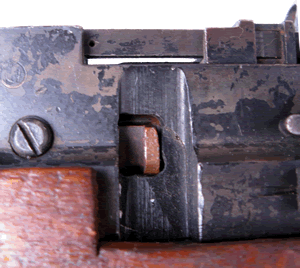
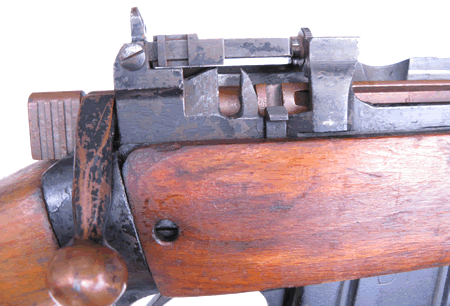
The copper-plating of the bolt, another safety and recognition feature, assists with clarification of the components in shown in the images.
The LH lug on the LH side of the action is shown right.
The thinning of the receiver wall by the milled slot has opened up the locating groove for the LH bolt lug, which has been itself reduced in thickness to weaken it to the same level as the RH lug.
The bolt is shown below left, compared with the standard No.4 bolt to more clearly show the weakening cuts.
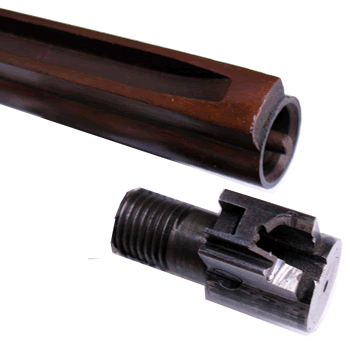
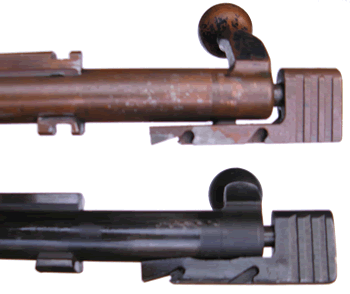
Right: the striker / firing pin is ground-off flush to the end face of the bolt-body,well clear of the bolt-head.
The bolt-head itself has, in this instance, the striker-hole remaining unfilled, but the extractor has been removed and its replacement made impracticable by the grinding away of the support for its fulchrum screw.
This makes the use of the rifle with dummy drill cartridges a one way affair. The chamber is clear to load such a cartridge, but it cannot be extracted by simply opening the bolt.
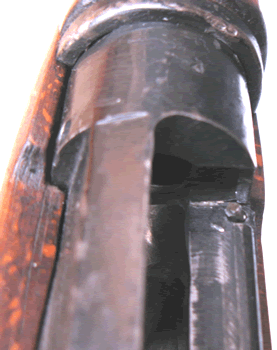
The harden pin, fitted into the bolt-way at the forward end of the rail, is shown left.
As described in Peter Laidler's article, this pin is yet another safety modification
- preventing a bolt that has been re-fitted with a live bolt-head from closing on the breech.
Right, the effects of receiver cuts are more evident with the bolt removed.
The cut-out in the fore-end woodwork reveals the milled slot in the LH side of the barrel. At the rear of the slot, nearest the receiver (below right), the barrel forward of the chamber is left open. Any attempt to modify the bolt, in an effort to load and fire a live round, would result in the escape of pressure and the dramatic arrival of the bullet at the weld-blocked forward part of the barrel ahead of the milled slot (below left).
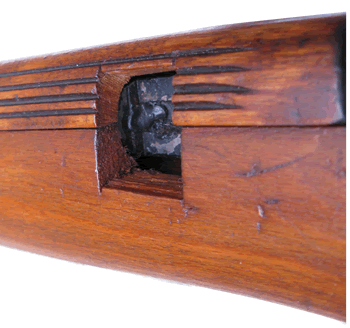
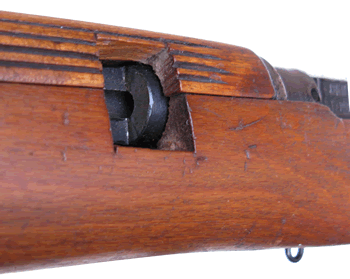
Were the action not to have been weakened by the milled cuts previously mentioned,
the removal of the barrel forward of this cut-out may have afforded a miscreant a viable
and secretable weapon.
The latter modifications to the action mean that such action should,
at worst, result in relatively
minor personal injury to the user or any accomplice standing to his left!
A point worth noting , if you have a yen to acquire one of these DP rifles, is that whilst the Military deem the deactivation of the L59 rifles to be perfectly adequate, and indeed to meet the letter of current civilian legislative law, the Home Office, and your local Firearms Enquiry Officer, probably think otherwise, and would expect such an "arm" to be held under Section 1 on a Firearms Certificate.
That rifles were occasionally less formally prepared by unit armourers could be evidenced by one seen recently,
of which four images are provided below.
Each of the two rifles shown lacks the bar sometimes fitted vertically through the chamber, which prevented chambering of any cartridge.
Where a pin was fitted, it is of course not possible to use practice dummy drill rounds in what is designed to be a drill rifle.
It should perhaps be considered that these rifles were intended more for parade ground drill than for firearms loading and firing drill practice.

On this rifle. the marking "Drill Rifle L59-A1" is very poorly electro-pencilled ahead of the No.4 Mk.1factory marks.
The slot milled in the action side, where the bolt locking-lug locates, is clearly shown.
Welds just visible to the rear of the handguard either side of the barrel reinforce prevent removal and replacement of the barrel.
In this instance, the welds intrude upon the chamber to the point where a drill round will not quite fully chamber.
When a drill round does chamber properly, the point of the bullet is just visible in the sectioned bore of the fore-end cut-out.
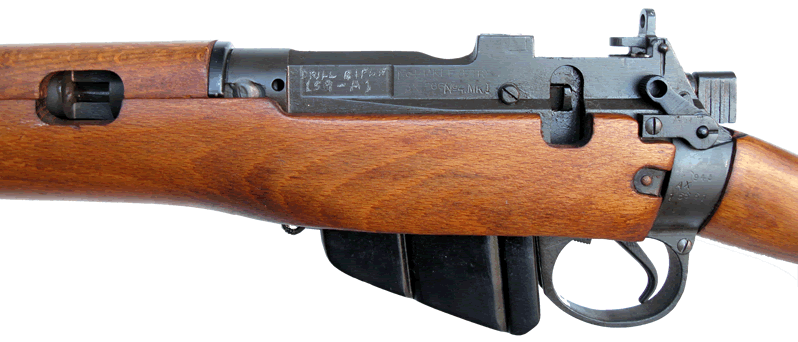
Each of these two rifles has the wartime Emergency / Economy flip-over 300/600 yard rear-sight fitted in place of the more usual folding leaf.
Left: the cutaway showing the welded barrel in the milled slot, and, right, the simply trimmed striker and weld-blocked striker-hole in the bolt-head.
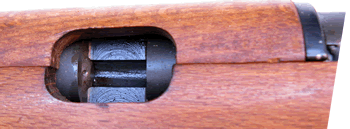 ........................
........................ 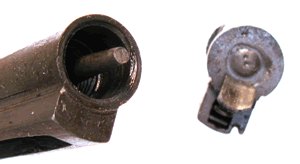
Unmarked as an L59A1, the next rifle is unlikely to have been an officially issued model, as an enterprising soul
has had the rifle converted and the major parts chromium plated.
"DP" is here stamped on both sides of the magazine.

Certainly a talking point!
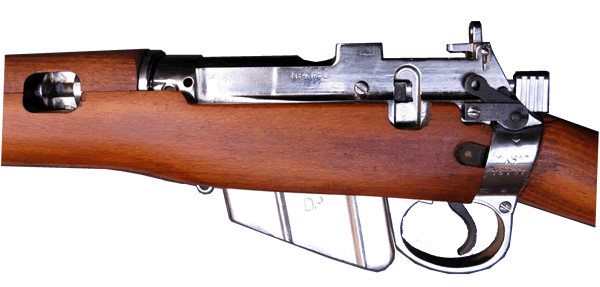
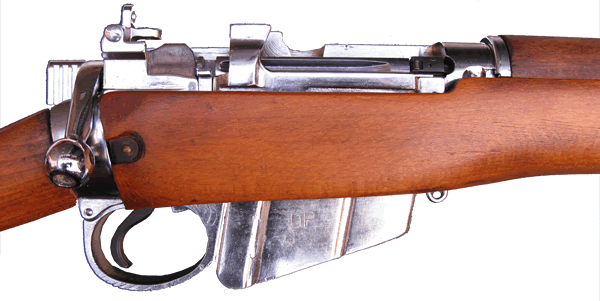
Please also visit the pages for the live .22RF training versions of the No.1 and No.4 Lee-Enfield rifles ..............
The .22 No.I Mk.III and No.2 Mk.IV* , the No.5 Rifles, the No.6 Rifles, the No.7 Rifles, the No.8 Rifles, and the No.9 Rifle.
 There was an interesting occurrence concerning
those L59A1 rifles (March 2009) previously in use by New Zealand's various
Cadet Forces. Their Lee-Enfield No.8 and Lee-Enfield No.9 rifles were taken
out of service, and it was proposed by some NZ authorities that they should
be destroyed. A campaign, by shooters and collectors of such historically
significant rifles, convinced those authorities that both New Zealand's
military heritage and the nation's coffers would be better served by the
sale of these non-threatening firearms to collectors such as themselves.
In the event, a total of 450 rifles were saved from destruction. The sale
was handled by Turners Auctions, and their catalog may still be available
at www.turners.co.nz
There was an interesting occurrence concerning
those L59A1 rifles (March 2009) previously in use by New Zealand's various
Cadet Forces. Their Lee-Enfield No.8 and Lee-Enfield No.9 rifles were taken
out of service, and it was proposed by some NZ authorities that they should
be destroyed. A campaign, by shooters and collectors of such historically
significant rifles, convinced those authorities that both New Zealand's
military heritage and the nation's coffers would be better served by the
sale of these non-threatening firearms to collectors such as themselves.
In the event, a total of 450 rifles were saved from destruction. The sale
was handled by Turners Auctions, and their catalog may still be available
at www.turners.co.nz
Included in the auction were 285 of the No.8 rifles, 116 of the No.9 (N.9) rifles and 53 of these .303 No.4 Drill Purpose rifles.
To obviate the purchase of large quantities by dealers, collectors were allowed to buy a maximum of one of each type.
One such purchaser has written to us to say ........."With our new acquisitions, a lot of us are now in need of information from sites such as yours. Congratulations on a great site, and thankyou for providing a great source of information."
We are grateful to this enthusiastic collector, who has provided this image of the rifles displayed at the sale. The picture is a sight for sore eyes.
For past information on the sale (and perhaps other archived photos) you can go to: MilitariaNZ
Return to: TOP of PAGE
See this website's Raison d'être